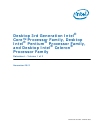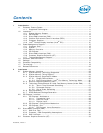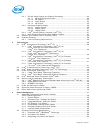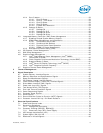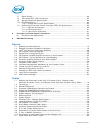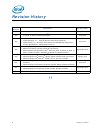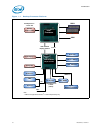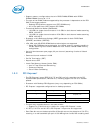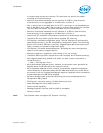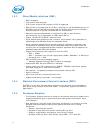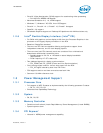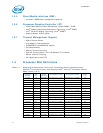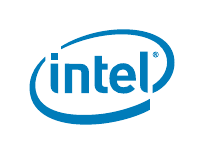
4
Datasheet, Volume 1
2.4.1 3D and Video Engines for Graphics Processing ............................................33
2.4.1.1 3D Engine Execution Units..........................................................33
2.4.1.2 3D Pipeline...............................................................................34
2.4.1.3 Video Engine ............................................................................34
2.4.1.4 2D Engine ................................................................................35
2.4.2 Processor Graphics Display ......................................................................36
2.4.2.1 Display Planes ..........................................................................36
2.4.2.2 Display Pipes ............................................................................37
2.4.2.3 Display Ports ............................................................................37
2.4.3 Intel
®
Flexible Display Interface (Intel
®
FDI) .............................................37
2.4.4 Multi Graphics Controllers Multi-Monitor Support .........................................37
2.5 Platform Environment Control Interface (PECI) ......................................................38
2.6 Interface Clocking..............................................................................................38
2.6.1 Internal Clocking Requirements ................................................................38
3 Technologies............................................................................................................39
3.1 Intel
®
Virtualization Technology (Intel
®
VT)..........................................................39
3.1.1 Intel
®
Virtualization Technology (Intel
®
VT) for
IA-32, Intel
®
64 and Intel
®
Architecture
(Intel
®
VT-x) Objectives..........................................................................39
3.1.2 Intel
®
Virtualization Technology (Intel
®
VT) for
IA-32, Intel
®
64 and Intel
®
Architecture
(Intel
®
VT-x) Features ............................................................................40
3.1.3 Intel
®
Virtualization Technology (Intel
®
VT) for Directed
I/O (Intel
®
VT-d) Objectives ....................................................................40
3.1.4 Intel
®
Virtualization Technology (Intel
®
VT) for Directed
I/O (Intel
®
VT-d) Features.......................................................................41
3.1.5 Intel
®
Virtualization Technology (Intel
®
VT) for Directed
I/O (Intel
®
VT-d) Features Not Supported..................................................41
3.2 Intel
®
Trusted Execution Technology (Intel
®
TXT) .................................................42
3.3 Intel
®
Hyper-Threading Technology (Intel
®
HT Technology)....................................42
3.4 Intel
®
Turbo Boost Technology............................................................................43
3.4.1 Intel
®
Turbo Boost Technology Frequency..................................................43
3.4.2 Intel
®
Turbo Boost Technology Graphics Frequency.....................................43
3.5 Intel
®
Advanced Vector Extensions (Intel
®
AVX)....................................................44
3.6 Security and Cryptography Technologies...............................................................44
3.6.1 Intel
®
Advanced Encryption Standard New Instructions (Intel
®
AES-NI) ........44
3.6.2 PCLMULQDQ Instruction ..........................................................................44
3.6.3 RDRAND Instruction................................................................................45
3.7 Intel
®
64 Architecture x2APIC .............................................................................45
3.8 Supervisor Mode Execution Protection (SMEP) .......................................................46
3.9 Power Aware Interrupt Routing (PAIR)..................................................................46
4 Power Management .................................................................................................47
4.1 Advanced Configuration and Power Interface
(ACPI) States Supported.....................................................................................48
4.1.1 System States........................................................................................48
4.1.2 Processor Core / Package Idle States.........................................................48
4.1.3 Integrated Memory Controller States.........................................................48
4.1.4 PCI Express* Link States .........................................................................49
4.1.5 Direct Media Interface (DMI) States ..........................................................49
4.1.6 Processor Graphics Controller States .........................................................49
4.1.7 Interface State Combinations ...................................................................49
4.2 Processor Core Power Management ......................................................................50
4.2.1 Enhanced Intel
®
SpeedStep
®
Technology ..................................................50
4.2.2 Low-Power Idle States.............................................................................50
4.2.3 Requesting Low-Power Idle States ............................................................52



